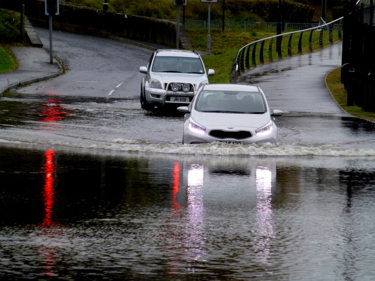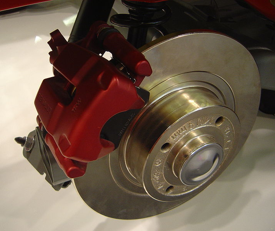
 I took the photo of the cars in the header image for this page - they were driving into about six centimetres of standing water at around 25mph. An instant after this picture was taken the red car lost control, the water was hiding a pothole. Luckily an accident was avoided. Perhaps next time the driver might not be so lucky. In the following 15 minutes I saw several near misses at the same spot.
I took the photo of the cars in the header image for this page - they were driving into about six centimetres of standing water at around 25mph. An instant after this picture was taken the red car lost control, the water was hiding a pothole. Luckily an accident was avoided. Perhaps next time the driver might not be so lucky. In the following 15 minutes I saw several near misses at the same spot.
Some areas are more prone to flooding than others. This problem is likely to increase in the UK as climate change disrupts weather patterns further.
Floods can occur when rivers burst their banks after a period of heavy rainfall.
Large volumes of water can cause flash-floods or floods in urban areas where the sewers and drains can't cope, leaving nowhere for the water to soak away.
With driving 'emergencies', prevention is better than cure. In the case of flooding, this means watching the weather forecasts before you set out on a journey. If flooding is widespread, you might be better off cancelling trips that are not necessary.
Except for flash floods, a flood only has the potential to become an emergency if you choose to drive through it. A flash flood is a guaranteed emergency.
If you are in a flood-affected area, consider moving your car to a place of safety when you first hear the weather warnings. But be aware that if flooding has already started, driving your vehicle could pose a serious risk - never underestimate the dangers of floodwater. Even strong swimmers have drowned in floods.
The only 100% guarantee to avoid being stranded or 'washed away' when driving through flood water is... Don't drive through flood water - find another route.

Flash floods can come rapidly and unexpectedly. In the UK they are usually caused when rivers break their banks.
You may not have a warning that a flash flood is approaching.
Flooding can wash away the entire road surface and a significant amount of ground beneath. Never attempt to drive through a flood that you couldn't walk through, and be aware that water can hide dips in the road. Worse still, there may be no road at all under the water.
Just six inches of water will reach the bottom of most passenger cars; this depth can cause loss of control or possible stalling when water gets sucked into the exhaust or washes into the air intake.
If negotiating a flooded section of road, drive in the middle where the water will be at its shallowest.
Consider other drivers - pass through flooded sections one car at a time, don't drive through floodwater when there are approaching vehicles.
Many cars will start to float in as little as one foot of water - this can be extremely dangerous because as the wheels lose grip, you lose control.
Two feet of flowing water can sweep away most vehicles — including large four-wheel drive cars. Don't try driving through fast-moving water, for example, approaching a flooded bridge – your vehicle could be swept off the bridge and away downstream.
 Driving at speed into water that is more than about 15 centimetres deep can have dramatic effects - it could almost feel like hitting a brick wall.
Driving at speed into water that is more than about 15 centimetres deep can have dramatic effects - it could almost feel like hitting a brick wall.
It's essential to watch your speed on roads where there might be unexpected patches of water (perhaps hidden by a bend or a dip in the road).
If you intend to drive through a flooded section of road, your first task is to check the depth of the water. In most cars, you should never attempt to drive through water more than 25 centimetres deep (or up to the centre of your wheels).
It's also worth checking where the air intake is on your engine. If water gets sucked into the engine, it will stall, but worse than this, it can cause severe damage that will require extensive repairs to bring it back to life.
Do not try to restart an engine that has sucked in water - the plugs or injectors will need to be taken out to allow the water to be expelled.
Some four-wheel-drive vehicles have high-level air intakes that allow them to drive through water several feet deep. However, you can say goodbye to your deep pile carpet and high fashion trainers if you attempt this!
We've already mentioned flowing water - even 4x4 vehicles can be washed away. If the water is fast-flowing - even 30 centimetres depth could wash your car off the road.
Where possible flooded roads are best negotiated by one vehicle at a time. Wait for approaching vehicles to clear the water before you start to drive through.
The advice here also applies to crossing fords - the main difference is that a ford will often have a depth gauge at the side of the road to help you to determine how deep the water is.
In a manual car, use first or second gear drive slowly to avoid creating a large 'bow wave' - a small wave can be helpful, but too much and the water can wash back into the engine and swamp the electrics. Slipping the clutch and revving the engine will also help to keep the exhaust clear and keep the engine running if water splashes onto the electrics.
When driving an automatic car, keep your foot on the gas in the lowest held gear and use the brake to control your speed.
In an electric car - if you must drive through, drive slowly...
(2022) It's still too early to be 100% sure about how a wide range of electric vehicles will cope with floods. Some people have demonstrated that you can safely drive through 20/30 cm of water without any problems; others warn of 'catastrophic danger'. We are not experts in flooding and electric cars, but we would advise caution. Electricity and water are not a good combination. You might be relatively safe in an electric vehicle in water - but there is not yet much information about the long term effects on vehicle components that have been immersed in water. This YouTube video of one driver's experience suggests that there is no problem
Our advice, for now, would be that you should not drive your EV through any water more than 10 cm deep - we would love to hear about your experience if you have driven your EV through a flood.
Any car: If your wheels start to lose grip partway through a flooded section, your car might be starting to float. To counter this, open a door and allow some water into the vehicle; this will weigh it down, enabling the tyres to grip again - it's probably best to get a passenger to do this so that you can continue revving your engine and slipping the clutch.
You will probably never find yourself in this situation in day-to-day driving, but overland 'adventurers' or aid workers might sometimes have no choice - they have to cross fast-flowing rivers. It's suggested that in this situation you open the vehicle doors, or better still, take the doors off before crossing!
Here's an expert off-roader at work
In some cases, a stalled engine can result in water being sucked back through the exhaust into the cylinders - this can cause extensive and expensive damage. Do not change gear because this can also cause water to be sucked back through the exhaust (due to the change in engine speed and manifold depression).
Another potential cause of damage in petrol/diesel cars is a cracked catalytic converter ('cat'). The 'cat' is part of the exhaust system and works at high temperatures; if it comes into contact with cold water, the metal's rapid contraction could crack the welded sides - OK if you have plenty of money to replace it!
Take a look at this video from 2013.- the principles are still the same today: 'Why it's dumb to drive through water.'
Unless you have a high ground clearance 4x4 and know what you are doing, avoid floods if you love your car!
 After driving through a flooded section of road or a ford across a river, test your brakes (whilst still moving slowly); this is necessary because wet brakes can be inefficient.
After driving through a flooded section of road or a ford across a river, test your brakes (whilst still moving slowly); this is necessary because wet brakes can be inefficient.
The picture shows a brake on a modern car. The red bit has pads that squeeze onto the metal disc to slow it down - if you ride a bike, this is similar to how most bicycle brakes work. Water and any greasy deposits can act as a lubricant between the pads and the disc.
Test your brakes by pressing them gently to determine if they are working OK. If not, you can dry them off by driving slowly for a short distance with your foot on the brake pedal.
Sometimes driving very slowly while pressing the brake pedal at the same time can cause your car to stop (or possibly stall in a manual). You can overcome this problem by touching the brake pedal very lightly with your left foot as you accelerate gently.
Caution: Practise left-foot braking by driving at less than ten mph on an empty stretch of road to discover what very lightly means!
In a manual car, your left foot doesn't need to be sensitive as it ‘thrusts' the clutch pedal down, so it isn't programmed to be gentle - you need to be aware of this and make a conscious effort to touch the brake pedal lightly.
Your left foot has no driving experience in an automatic or electric car! You will need to teach it how to be gentle.